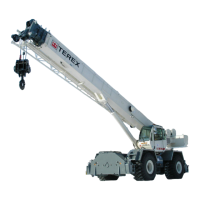INTRODUCTION
A regular program of periodic preventive maintenence
is essential to prolong crane operating life, maximize
efficient service and minimize downtime. This section
details a series of checks and procedures which are to
be performed at daily, weekly, monthly and semi-annu-
al intervals. These intervals are stated both in terms of
calendar periods and hours of operation.
The checks prescribed for longer intervals include all
the checks required for the shorter intervals. Thus, the
weekly check includes all items in the daily check, the
monthly check includes weekly and daily checks, and
so on through the semi-annual check, which includes
the quarterly, monthly, weekly and daily checks.
A convenient check chart provides a means of record-
ing preventive maintenance performed and serves as
a tool detecting problem areas and reanalyzing main-
tenance requirements. The items in each check inter-
val on the check chart are grouped under their
respective headings and covered in detail over the
course of Section 6.
This maintenance schedule is a guide which ensures
that basic preventive maintenance requirements will
be met under average operating conditions. Condi-
tions which impose greater wear, loads or strain on the
crane may dictate reduced check intervals. Before al-
tering the maintenance schedule, reevaluate crane op-
eration and review the crane maintenance records.
Consider all factors involved and develop a revised
schedule adequate to meet routine maintenance re-
quirements.
As a part of each periodic check, refer to the engine
manufacturer’s manual for engine maintenance re-
quirements. When servicing the engine, the engine
manufacturer’s recommendations take precedence
over those in this manual, should any discrepancy be
noted.
OPERATOR OBSERVATION
As the operator, it is your responsibility to observe and
report any unusual sounds, odors, or other signs of ab-
normal performance that could indicate trouble ahead.
On a routine basis the following items should be
checked before starting or while operating the crane.
Visual Inspection - Check complete machine for any
unusual condition.
Check for any leaks or damage to the hydraulic sys-
tem.
Check in the engine compartment:
* Belts for tension and wear
* Coolant level
* Oil level
* Transmission oil level
* Air cleaner sight gauge
* Air intake
* Muffler and exhaust
Check battery box - For battery condition
Crane boom - Check for:
* Hook block for wear or damage
* Two block system for proper function
* Cable and cable spooling on winch
* Cylinder pin connections for wear
Check tires, axles, and drive lines, for wear or damage.
Check in the cab for:
* Instruments functioning properly
* Control operation
* Glass for good visibility
* Safety equipment is ready for use
* All lights work properly
* Cleanliness - Free from mud and debris.
MAINTENANCE CHECKS
4 - 2 Revised: March 2005RT700 Series

